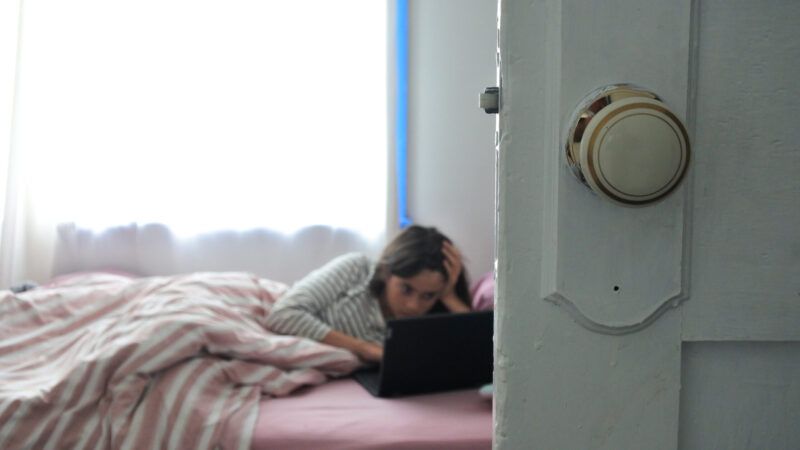Teacher Spying Is Instilling Surveillance Culture Into Students
“We totally stalked what they were doing on Google,” one teacher said.

For the teachers, it began in October at the California Teachers Association's 2021 LGBTQ+ Issues Conference. Lori Caldeira and Kelly Baraki explained how they identified potential new members of UBU, the school's club of LGBTQ supporters. "When we were doing our virtual learning—we totally stalked what they were doing on Google, when they weren't doing schoolwork," Caldeira said. "One of them was Googling 'Trans Day of Visibility.' And we're like, 'Check.' We're going to invite that kid when we get back on campus."
Whatever you think of LGBTQ issues, the fact that a teacher can remotely track what students do online should give you pause. This was not a case of a teacher reviewing the browser history on a classroom computer after school. As Caldeira said, albeit with her tongue in cheek, they were stalking the kids. (The title of Caldeira and Baraki's presentation declared that it was about running such clubs "in conservative communities." Needless to say, conservative teachers can snoop on kids' online activities too.)
The Buena Vista Middle School in Salinas, California, where Caldeira is employed (and is currently on leave, following the uproar over the story), uses GoGuardian, a standard software tool for monitoring what students do during Zoom classes. GoGuardian, which promotes itself as powering "digital learning environments where every student can thrive," is being used in about 30,000 schools.
Schools do, of course, have a vested interest in protecting students. Defenders of programs like GoGuardian point out that it could catch a student searching for, say, "how to commit suicide." But as with law, extreme cases make bad policy. If "digital learning environment" tools also collect data related to non-life-threatening behavior, can we expect school authorities to hold a line on what to flag and when to interfere?
GoGuardian's website features a testimonial from a district administrator. A student, new to the district, revealed in his journal he was struggling to fit in. Certain words tripped an alert, and the administrator was able to connect the student to support services. Perhaps that worked out for the best for this student, but most kids probably don't want school administrators reading their journals. (GoGuardian was unable "to get any exec spokesperson availability" to respond to my inquiries.)
Justin Reich, a former teacher who spent 15 years as an education technology consultant and who now directs MIT's Teaching Systems Lab, says, "Generally speaking, I think school policy gives quite wide leeway for schools and districts to have the capacity to view almost anything that happens on school devices, networks and services." And that worries him. "We need to consider how schools help induct students into a surveillance culture," he says.
Chris Gilliard of Macomb Community College pointed out on Reich's podcast, TeachLab, that schools have long been "a place where people watch and are watched." The difference today lies in which realm, the physical or the virtual, the watching takes place. Students are watched at school and then beyond campus via devices they access at home. What lines are schools drawing between necessary monitoring of student behavior, the requirements of mandatory reporting, and student privacy? Are these lines being codified in policies? Or are schools flying by the seat of their pants?
"Many of these tools were adopted in a rush at the start of the pandemic," says Elana Zeide, an expert on student privacy and artificial intelligence at the University of Nebraska School of Law. "But after two years of remote learning, they should have gotten themselves together and ironed their policies out."
It's not even clear that the tools are working the way they are supposed to. For example, Zeide says, there is little evidence that "online proctoring reduced cheating."
There is also the question of equity. School-issued devices are like work-issued ones, which are expected to be used strictly for work. Many students have access to a second device at home for personal use, and thus can evade the prying eyes of school surveillance tools. But this, Zeide points out, disadvantages lower-income students "who might have only the school-issued machine."
And Zeide has a larger concern too. "Surveilling students has been shown to have a chilling effect on their speech and their curiosity, what might be called their intellectual privacy," she says. If students feel they are being watched, they may be less likely to explore less "acceptable" ideas or to search the internet with questions they are embarrassed to ask in class.
If schools won't abandone online surveillance altogether, are there smaller steps they can take? Zeide wants better teacher training, since how well these tools work depends in part on how they are used. Schools can also turn surveillance off after school hours. (GoGuardian offers such an option.) And then there's transparency: Schools, Zeide says, should explain to parents what data is being collected, even if the data is not part of the student's permanent educational record.
"It may be best practice, but how many schools are actually practicing it?" I ask.
"That's a great question," Zeide replies.
Show Comments (59)